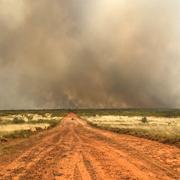
Hettan tar död på somrarna i Australien: ”Kan inte fly”
På andra sida jordklotet brukar australiensarna vanligtvis njuta av sommarvärmen så här års. Men de senaste åren har somrarna präglats av ovanligt varmt väder – var tionde dag har varit varmare än 35 grader, skriver BBC.
Kanalen har besökt västra Sydney, ett område med utbredd fattigdom och få möjligheter att fly hettan.
– Vi har ingen närliggande strand och kan inte fly från värmen, säger Sanaa Shah som bor i området.
Hon beskriver att hon de varmaste dagarna tvingas låsa in sig då hon får migrän av värmen.
bakgrund
Klimatförändringarna i Australien
Wikipedia (en)
Australia's climate is governed mostly by its size and by the hot, sinking air of the subtropical high pressure belt (subtropical ridge or Australian High). This moves north-west and north-east with the seasons. The climate is variable, with frequent droughts lasting several seasons, thought to be caused in part by the El Niño-Southern Oscillation. Australia has a wide variety of climates due to its large geographical size. The largest part of Australia is desert or semi-arid. Only the south-east and south-west corners have a temperate climate and moderately fertile soil. The northern part of the country has a tropical climate, varying between grasslands and desert. Australia holds many heat-related records: the continent has the hottest extended region year-round, the areas with the hottest summer climate, and the highest sunshine duration.
Because Australia is a medium-sized continent, separated from polar regions by the Southern Ocean, it is not subject to movements of frigid polar air during winter, of the type that sweep over the continents in the northern hemisphere during their winter. Consequently, Australia's winter is relatively mild, with less contrast between summer and winter temperatures than in the northern continents–though the transition is more dramatically marked in alpine regions of Australia and places of substantial elevation. Seasonal highs and lows can still be considerable. Temperatures have ranged from above 50 °C (122 °F) to as low as −23.0 °C (−9.4 °F). Minimum temperatures are moderated.
The El Niño–Southern Oscillation is associated with seasonal abnormality in many areas in the world. Australia is one of the continents most affected and experiences extensive droughts alongside considerable wet periods. Occasionally a dust storm will blanket a region and there are reports of the occasional tornado. Tropical cyclones, heat waves, bushfires and frosts in the country are also associated with the Southern Oscillation. Rising levels of salinity and desertification in some areas is ravaging the landscape.
Climate change in Australia is a highly contentious political issue. Temperatures in the country rose by approximately 0.7 °C between 1910 and 2004, following an increasing trend of global warming. Overnight minimum temperatures have warmed more rapidly than daytime maximum temperatures in recent years. The late-20th century warming has been largely attributed to the increased greenhouse effect. According to the Bureau of Meteorology (BOM), 80% of the land receives less than 600 mm (24 in) of rainfall annually and 50% has even less than 300 mm (12 in). As a whole, Australia has a very low annual average rainfall of 419 mm (16 in).
Omni är politiskt obundna och oberoende. Vi strävar efter att ge fler perspektiv på nyheterna. Har du frågor eller synpunkter kring vår rapportering? Kontakta redaktionen


